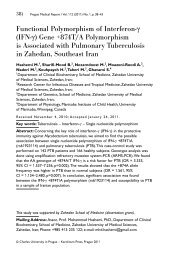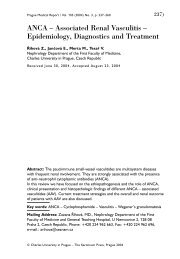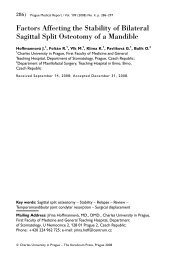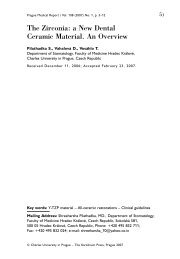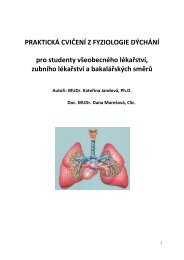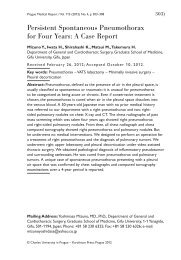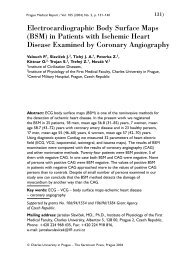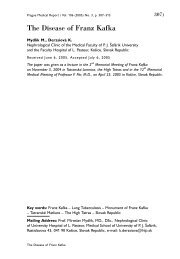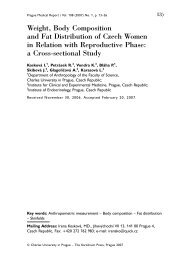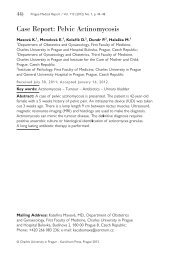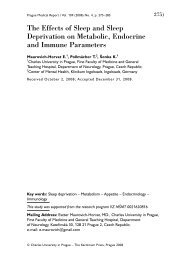(PDF). - Prague Medical Report
(PDF). - Prague Medical Report
(PDF). - Prague Medical Report
Create successful ePaper yourself
Turn your PDF publications into a flip-book with our unique Google optimized e-Paper software.
<strong>Prague</strong> <strong>Medical</strong> <strong>Report</strong> / Vol. 113 (2012) No. 2, p. 136–146<br />
139)<br />
Material and Methods<br />
Patients studied group<br />
Altogether 82 children (girls/boys: 43/39) suspected from neurometabolic disorder<br />
entered in this study aged from one months to 17 years (median 1.3 years). The CSF<br />
level of homovanillic acid (HVA) was markedly decreased in three children (64, 79<br />
and 94 nmol/l) in comparison to age related controls (lower limit 218–450). In only<br />
one patient the clinical presentation was consistent with the suspected diagnosis of<br />
THD. MRI studies in two other patients with microcephaly revealed postischaemic<br />
brain damage, therefore secondary HVA deficit was considered in these children.<br />
Informed consent was obtained from parents.<br />
Biochemical investigations<br />
Serum prolactin was estimated by chemiluminescence immunoanalysis on Centaur<br />
analyzer (CLIA Centaur, Siemens). CSF specimens were collected according to<br />
previously described protocol (Hyland, 2008). Neurotransmitter metabolites in<br />
CSF were measured by isocratic HPLC system using Phenomenex reversedphase<br />
column (C18, 250 mm × 2 mm; 4 µm). Mobile phase (pH 5.1) consisted of<br />
28 mmol/l citrate acid, 83 mmol/l sodium acetate, 100 µmol/l EDTA and methanol<br />
(85/15 v/v). Detection was performed by amperometric electrochemical detector<br />
Gilson 712 (850 mV) at a flow of 0.3 ml/min. Data were automatically collected and<br />
processed using software Gilson Appl. 712 (Figure 2A and 2B).<br />
Molecular investigations<br />
Total genomic DNA was isolated from blood lymphocytes by phenol-chloroform<br />
extraction. All 12 exons and adjacent intronic regions of the TH gene were amplified<br />
by PCR and analyzed by direct sequencing at genetic analyzer ABI3100 Avant<br />
(Applied Biosystems, USA). PCR primers were designed with use of Primer3<br />
software. The presence of mutation c.636A>C (p.Gln212Pro) was confirmed<br />
by PCR-RFLP with use of specific endonuclease BsrI. The presence of mutation<br />
c.1124G>C (p.Glu375Gln) was confirmed by HRM method at LightScanner<br />
instrument Idaho Technology, Inc. (Rozen and Skaletsky, 2000).<br />
Case report<br />
Six-year-old boy was born prematurely to healthy non-consanguineous parents<br />
after 31 weeks of gestation by caesarean section because of foetal distress. His birth<br />
weight (1,100 g) and birth length (34 cm) fulfilled the criteria for IUGR<br />
(–2 SDS). Perinatal respiratory distress with apnoea claimed ventilatory support<br />
for a few days. Postnatal brain ultrasonography was normal. Moderate muscular<br />
hypotonia and feeding difficulties were considered as a sequel of perinatal events.<br />
Muscle hypotonia persisted and at the age of three months he was diagnosed with<br />
psychomotor delay. Neurological picture during the first year of life developed into<br />
quadruspasticity, hypokinesia, facial hypomimia, dystonia, ptosis, microcephaly and<br />
Czech Patient with Tyrosine Hydroxylase Deficiency



